The dual-slope type of AtoD conversion is a very popular method for digital voltmeter applications. When compared to other types of analog-to-digital conversion techniques, the dual-slope method is slow but is quite adequate for a digital voltmeter used for laboratory measurements. For data acquisition applications, where a number of measurements are required, faster techniques are recommended. Many refinements have been made to the technique and many large- scale-integration (LSI) chips are available to simplify the construction of DVMs.
When a dual-slope AID converter is used for a DVM the counters may be decade rather than binary and the segment and digit drivers may be contained in the chip. When the converter is to interface to a microprocessor, and many high-performance DVMs use microprocessors for data manipulation, the counters employed are binary.
One significant enhancement made to the dual-slope converter is automatic zero correction. As with any analog system, amplifier offset voltages, offset currents, and bias currents can cause errors. In addition, in the dual-slope AtoD converter, the leakage current of the capacitor can cause errors in the integration and consequentially, an error. These effects, in the dual-slope AID converter, will manifest themselves as a reading of the DVM when no input voltage is
present.
Figure above shows a method of counteracting these effects. The input to the converter is grounded and a capacitor, the auto zero capacitor, is connected via an electronic switch to the output of the integrator. The feedback of the circuitry is such that the voltage at the integrator output is zero. This effectively places an equivalent offset voltage on the automatic zero capacitor so that there is no integration. When the conversion is made, this offset voltage is present to counteract the effects of the input circuitry offset voltages. This automatic zero function is performed before each conversion, so that changes in the offset volt- ages and currents will be compensated.Figure shows a complete dual-slope AID converter.
